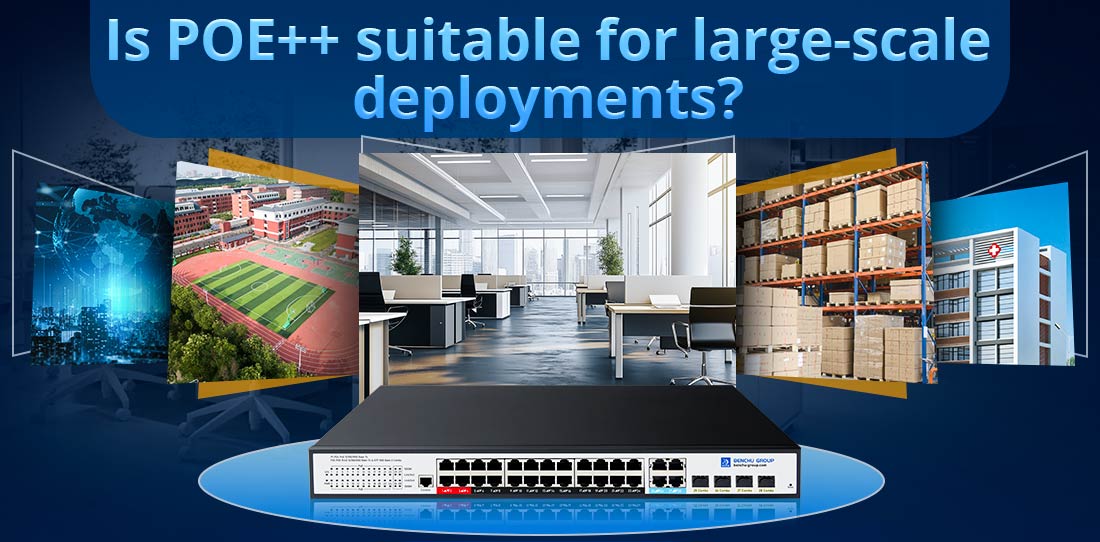
Sim, o PoE++ (Power over Ethernet Plus Plus) é adequado para implantações em larga escala, oferecendo inúmeras vantagens para alimentar e gerenciar dispositivos em redes expansivas. No entanto, a sua adequação depende dos requisitos específicos da implantação, tais como as necessidades de energia dos dispositivos conectados e a escalabilidade da infraestrutura. Abaixo está uma explicação detalhada:
1. Fornecimento de energia para dispositivos de alta demanda
PoE++ (IEEE 802.3bt) oferece até 90 W por porta, o que suporta uma ampla variedade de dispositivos que consomem muita energia. Em implantações em larga escala, esse recurso é particularmente útil para:
--- Pontos de acesso de alto desempenho para redes sem fio.
--- Câmeras PTZ com recursos avançados como iluminação IR.
--- Iluminação LED e displays em edifícios ou campi inteligentes.
--- Dispositivos IoT, como sensores industriais ou controladores automatizados.
Para dispositivos que exigem menos energia (por exemplo, telefones VoIP ou câmeras IP básicas), os switches PoE++ são compatíveis com padrões PoE anteriores (802.3af/at), tornando-os versáteis para redes de dispositivos mistos.
2. Infraestrutura simplificada
As implantações em larga escala geralmente enfrentam o desafio de gerenciar requisitos complexos de cabeamento e energia. PoE++ simplifica isso combinando energia e entrega de dados em um único cabo Ethernet:
--- Reduz custos de cabeamento: Elimina a necessidade de cabos de alimentação e de dados separados.
--- Simplifica as instalações: Agiliza o processo de implantação, principalmente em ambientes com centenas ou milhares de dispositivos, como escritórios, campi ou instalações industriais.
--- Libera espaço: Menos cabos significam menos confusão em eletrocalhas e racks, melhorando a organização do sistema.
3. Gerenciamento centralizado de energia
Em redes de grande escala, o gerenciamento centralizado de energia é crucial para a eficiência e a escalabilidade. PoE++ permite:
--- Alocação de energia: Interruptores inteligentes pode alocar energia dinamicamente aos dispositivos conforme necessário, otimizando o uso.
--- Monitoramento e Controle Remoto: Os administradores podem monitorar o consumo de energia, reinicializar dispositivos ou gerenciar o fornecimento de energia remotamente por meio do sistema de gerenciamento de rede.
--- Escalabilidade: Adicionar mais dispositivos é fácil, desde que o switch PoE++ tenha portas disponíveis e orçamento de energia.
4. Escalabilidade para redes em expansão
PoE++ é bem dimensionado para grandes implantações:
--- Switches de alta densidade: Muitos switches PoE++ são projetados com grande número de portas, suportando vários dispositivos em uma única unidade.
--- Sistemas Modulares: Os administradores de rede podem implantar vários switches PoE++ em locais estratégicos e expandir a rede de forma incremental sem revisar a infraestrutura.
--- Suporte para dispositivos IoT e Edge: O PoE++ é adequado para o número crescente de dispositivos de borda em redes modernas, permitindo escalabilidade preparada para o futuro.
5. Eficiência Energética
Implantações em larga escala se beneficiam significativamente dos recursos de economia de energia do PoE++:
--- Entrega otimizada: Os sistemas PoE++ minimizam a perda de energia durante a transmissão de energia.
--- Alocação dinâmica de energia: A energia é fornecida apenas aos dispositivos ativos, reduzindo o desperdício.
--- Conformidade com Padrões Verdes: Muitas soluções PoE++ são projetadas para atender aos padrões ambientais e de eficiência energética, tornando-as ideais para projetos preocupados com a sustentabilidade.
6. Versatilidade entre casos de uso
PoE++ oferece suporte a uma ampla variedade de aplicações em implantações em larga escala:
--- Cidades Inteligentes: Alimentando câmeras de trânsito, sensores e pontos de acesso Wi-Fi públicos.
--- Campi de saúde: Suporte a equipamentos médicos, monitoramento de pacientes e sistemas de informação.
--- Escritórios Corporativos: Habilitando sistemas VoIP, câmeras de vigilância e iluminação avançada.
--- Campi de Educação: Alimentando placas inteligentes, câmeras IP e sistemas de controle de acesso.
--- Ambientes Industriais: Alimentando dispositivos IoT robustos e equipamentos de rede em fábricas ou armazéns.
7. Limitações e soluções de alcance
Embora o PoE++ tenha um limite de comprimento de cabo de 100 metros (328 pés), isso normalmente é suficiente para a maioria das implantações em grande escala. Para distâncias estendidas, as soluções incluem:
--- Extensores PoE: Aumente o alcance em mais 100 metros por extensor.
--- Fibra Óptica com Conversores de Mídia PoE: Forneça dados de alta velocidade em longas distâncias enquanto integra PoE no endpoint.
--- Posicionamento estratégico do switch: Implante switches mais próximos dos clusters de dispositivos para permanecer dentro do alcance efetivo.
8. Considerações sobre custos
PoE++ reduz custos a longo prazo ao:
--- Custos de instalação mais baixos: Requer menos mão de obra e materiais em comparação com configurações separadas de energia e dados.
--- Manutenção Centralizada: Simplifica a solução de problemas e a manutenção.
--- Eficiência Energética: Minimiza os custos operacionais através do uso otimizado de energia.
Os investimentos iniciais em switches e infraestrutura PoE++ podem ser maiores do que as soluções tradicionais, mas a economia de custos e os benefícios operacionais tornam-no uma escolha econômica para implantações em grande escala.
9. Desafios e Mitigação
Embora o PoE++ seja altamente adequado para implantações em larga escala, considere o seguinte:
--- Restrições do orçamento de energia: Cada switch PoE++ possui um orçamento máximo de energia. Em implantações de alta densidade, certifique-se de que o switch possa atender às necessidades totais de energia dos dispositivos conectados.
--- Solução: Use switches com orçamentos de energia mais altos ou distribua dispositivos entre vários switches.
--- Gerenciamento de calor: Interruptores PoE++ gerar mais calor devido à maior produção de energia.
--- Solução: Garanta sistemas adequados de ventilação e resfriamento nas salas de equipamentos de rede.
Conclusão
PoE++ é uma solução robusta e escalável para implantações em grande escala, fornecendo alta potência, infraestrutura simplificada, gerenciamento centralizado e excelente eficiência energética. Sua capacidade de suportar diversos dispositivos e recursos preparados para o futuro o tornam ideal para empresas, cidades inteligentes, instalações industriais e outros projetos de grande escala. Embora existam considerações como orçamento de energia e limitações de alcance, estas podem ser mitigadas através de planeamento e implementação adequados.